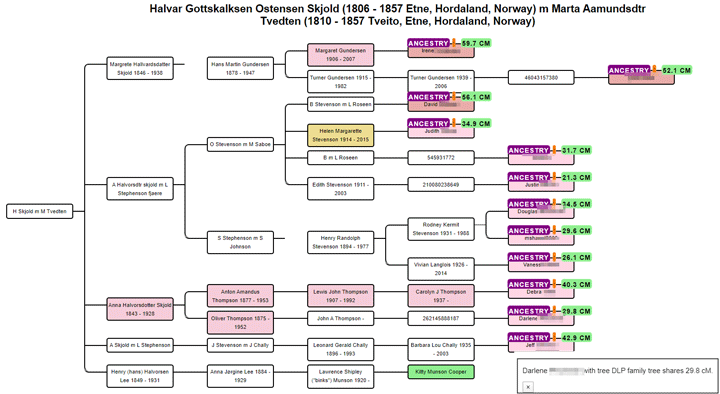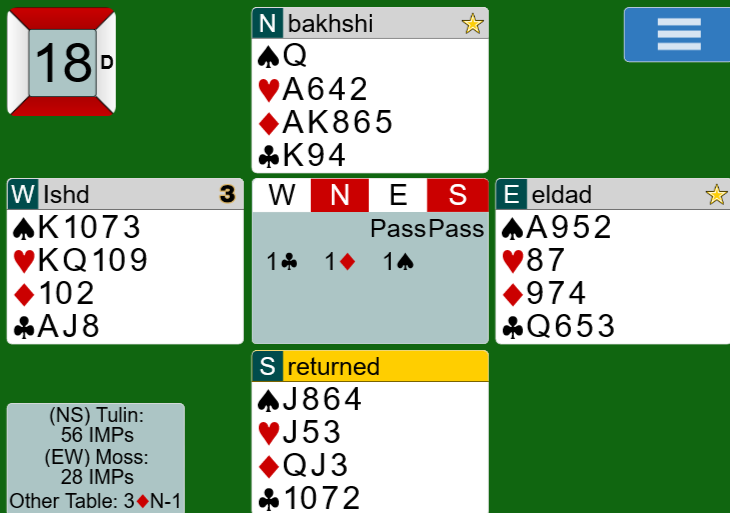Clustering has changed the way many of us work on genealogy mysteries and unknown parentage cases. Genetic Affairs was just one of the sites offering automated clustering (click here for my first clustering post), but then they added tree building. That’s right, they make tree diagrams for each cluster that has at least two people with trees that can be matched up. They even include a GEDcom for those trees in the zip file they send.
One way I use these diagrams is to show cousins how we are related. Another way I use this feature, is to solve unknown parentage cases. I use both DNA2tree and Genetic Affairs and then go with whichever seems to have the more relevant looking trees. The advantage of Genetic Affairs (GA) is that it will look at the unlinked trees and at your ThruLines. Also the output is easy to glance over to see what is worth pursuing, once you are used to the format. Click here for my recent post on automated tree-building tools.

Above is the diagram GA built for the descendants of my gg-grandparents who are in the lonely box on the far left. Click on the image for a larger image in a new tab. My great grandparents lived on farm Skjold in Etne, Hordaland, Norway and had eight children, four of whom, plus the child of another, emigrated to the USA and have many tested descendants at Ancestry.
Here is a key to what you are seeing. The green box on the bottom line is me. The mustard yellow box means that the match’s unlinked tree was used from that person on down. The people in pink in the middle were determined from my ThruLines. Living people are shown as just id numbers, except for your matches who are shown by the name they have chosen to be seen as. All DNA matches are on the far right and are also colored pink with the source and the amount shared listed. Clicking on a match gets a little box to pop up in the lower right corner (as shown) with the name of their family tree, clickable to their Ancestry tree.
UPDATE 24 Jun 2020: Clustering on Ancestry is no longer available as they issued a cease and desist order to Genetic Affairs and many other 3rd party sites. Please click here and send a suggestion to Ancestry that they implement clustering on their site.
The purple box with the word ANCESTRY indicates the source of the tree information. Another GA feature is the ability to cluster both your Family Tree DNA matches and your Ancestry matches together.
When names are listed differently in other trees they will be shown in these diagrams as separate people. Notice that in the second from the left column, that the software could not tell that the A. Skjold who married L. Stephenson is the same person as the A. Halvorsdtr skjold who married L. Stephenson Fjaere. Norwegians did not have fixed surnames so we usually use the farm name as a surname in our trees. Often upon arriving in this country they often chose to use the patronymic, so Stephenson rather than Fjaere (click here for more on Norwegian naming). However the other Anna Halvorsdtr Skjold listed between those two really is a different person and she married a Thompson. Reusing first names is another bane of the Norwegian genealogist.
This tree building capability from Genetic Affairs recently helped me solve an unknown father mystery.
When “Amy” discovered her brother was only a half brother by doing an Ancestry DNA test, she was very surprised. She had heard that her mother was pregnant with her when marrying her late father, but everyone knew he was her Dad, or so she thought. Her mother was not willing to discuss this, so she asked for my help to figure out her biological father from the DNA.
Continue reading →



